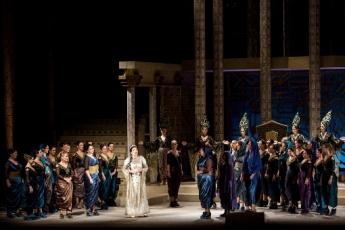Karl [Károly] Goldmark – The Queen of Sheba (Die Königin von Saba) [2015]
Karl [Károly] Goldmark – The Queen of Sheba (Die Königin von Saba) [2015]

01. Vorspiel zum 1. Akt 02. Tritt ohne Zagen ein; Mein Assad kehrt zurück [Der Hohepriester, Sulamith, Chor] 03. Am Fuss des Libanon; Ob dich ein böser Zauber quälte [Assad, König Salomon] 04. Aus des Jubels Festgepränge [Die Königin von Saba] 05. Magische Töne; Kommst du endlich wieder [Assad, Die Königin von Saba] 06. Die Stunde, die mir ihr geraubt [Sulamith, König Salomon, Chor] 07. Assad! - Wer ruft mir [Assad, Die Königin von Saba] 08. Komm, Tod [Assad, Sulamith, Chor] König Salomon – Kelemen Zoltán Der Hohepriester – Fried Péter Sulamith – Sümegi Eszter Assad – Nutthaporn Thammathi Die Königin von Saba – Gál Erika Choir & Orchestra of Hungarian State Opera Conductor – Kovács János 29 & 31 october 2015, Erkel Theatre, Budapest
According to the ancient scriptures, the Queen of Sheba was obsessed with finding Wisdom, and so she journeyed to meet Solomon, who was known to be the wisest of all the rulers of the time, in order to put his knowledge to the test. Goldmark, who was born in Hungary to a religious Jewish family and forever remained true to his native country's culture even after moving to Vienna, was inspired by the beauty of one of his students to write this feverish and biblically-themed tale of a love triangle between the temperamental queen, a young Jerusalem diplomat and the daughter of the high priest. --- jegymester.hu
Goldmark's first opera, Die Königin von Saba (The Queen of Sheba), proved to be his most famous and enduring work. Although most successful on German stages, Die Königin von Saba has played often outside that country and has been translated into numerous languages.
Goldmark first thought of composing an opera on the biblical character of the Queen of Sheba in 1863, and he charged Salomon Hermann Mosenthal with the task of drawing up a libretto. Based on the First Book of Kings, Chapter 10, Mosenthal's first libretto was found unacceptable by Goldmark, and two years passed before Mosenthal was able to revise the text to his satisfaction. Goldmark began composing the opera in 1865 and eventually altered Mosenthal's original happy ending. Composition proved arduous, and Goldmark was able to finish only after he received a grant from the Hungarian government. Die Königin von Saba premiered on March 10, 1875, at the Vienna Court Opera.
In the Bible, the Queen of Sheba visits Jerusalem to see Solomon's court, speak with Solomon and "test him with subtle questions." He passes her tests, and she is very impressed with the palace and Solomon's prosperity. To this basic scenario Mosenthal added a love triangle. The Queen entrances one of Solomon's diplomats, Assad, who is betrothed to Sulamith, the daughter of Solomon's high priest. Although, in private, the Queen reveals her attraction to Assad, in public she denies even knowing him. This drives Assad to commit blasphemy. For this he is banished to the desert, where he dies in Sulamith's arms. The content of Die Königin von Saba is similar to that of Saint-Saëns' Samson et Dalila, which premiered two years after Goldmark's biblical tale.
Goldmark's debt to Wagner is clear not only from his actions -- he helped form the Vienna Wagner Society -- but in his music. Die Königin von Saba is filled with Wagnerian chromatic harmony and an occasional use of the leitmotif technqiue. What distinguishes Goldmark's work, however, is that this chromatic harmony supports songlike, closed forms that often contain Italianate, bel canto melodies. Declamation styles run the gamut from recitative to fluid arias to large choruses. Elements of French grand operas, particularly those of Meyerbeer, appear in the crowd scenes, the ballet in Act Three, and the historical subject matter. It is in the evocation of local color that Goldmark is at his best. Eastern modes and harmonic minor scales flavor the music surrounding the Queen of Sheba, while traditional Jewish melodies inform the music Goldmark uses for the religious ceremonies in the opera and the music associated with the Ark of the Covenant. All these aspects are conveyed with lush, masterfully manipulated orchestral tone colors that, again, bear the stamp of Wagner. ---John Palmer, allmusic.com
download (mp3 @320 kbs):
yandex 4shared mega mediafire uloz.to cloudmailru gett








